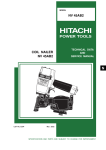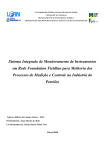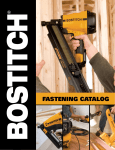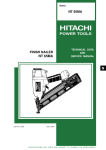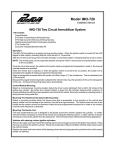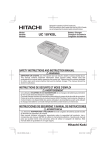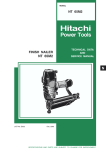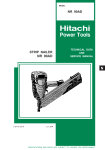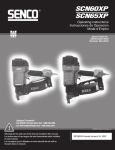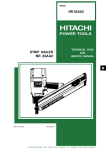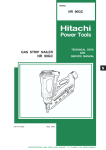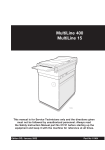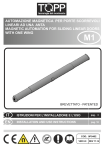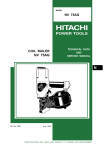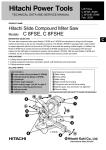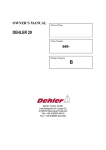Download COIL NAILER Model NV 45AC
Transcript
MODEL NV 45AC POWER TOOLS COIL NAILER NV 45AC TECHNICAL DATA AND SERVICE MANUAL N LIST No. 1098 Nov. 2000 SPECIFICATIONS AND PARTS ARE SUBJECT TO CHANGE FOR IMPROVEMENT CONTENTS Page 1. PRODUCT NAME .............................................................................................................................. 1 2. MARKETING OBJECTIVE ................................................................................................................ 1 3. APPLICATIONS ................................................................................................................................. 1 4. SELLING POINTS ............................................................................................................................. 1 5. SPECIFICATIONS ............................................................................................................................. 2 5-1. Specifications ......................................................................................................................................2 5-2. Nail Selection ......................................................................................................................................3 5-3. Nail Driving Force ...............................................................................................................................4 5-4. Optional Accessories ..........................................................................................................................5 6. COMPARISONS WITH SIMILAR PRODUCTS ................................................................................. 6 7. PRECAUTIONS IN SALES PROMOTION ........................................................................................ 7 7-1. Instruction Manual ..............................................................................................................................7 7-2. Warning Label .....................................................................................................................................7 7-3. Related Laws and Regulations ...........................................................................................................8 8. MECHANISM AND OPERATION PRINCIPLE .................................................................................. 8 8-1. Mechanism .........................................................................................................................................8 8-2. Operation Principle ...........................................................................................................................10 9. TROUBLESHOOTING GUIDE ........................................................................................................ 12 9-1. Troubleshooting and Correction ........................................................................................................12 9-2. Possible Causes and Corrections of Air Leakage .............................................................................17 10. DISASSEMBLY AND REASSEMBLY ........................................................................................... 19 10-1. General Precautions in Disassembly and Reassembly .................................................................. 19 10-2. Disassembly and Reassembly of the Output Section ..................................................................... 20 10-3. Disassembly and Reassembly of the Control Valve Section ..........................................................22 10-4. Disassembly and Reassembly of the Driving Section .................................................................... 25 10-5. Disassembly and Reassembly of the Cap and the Magazine Section ........................................... 29 11. INSPECTION AND CONFIRMATION AFTER REASSEMBLY ..................................................... 32 12. STANDARD REPAIR TIME (UNIT) SCHEDULES ........................................................................ 33 [ Appendix] Assembly Diagram for NV 45AC .............................................................................................................34 1. PRODUCT NAME Hitachi 1-3/4" Coil Nailer, Model NV 45AC 2. MARKETING OBJECTIVE The current Model NV 45AB coil nailer is well-reputed in the U.S.A. market as a roofing nailer suitable for roofing asphalt shingles in building construction. However, competitively priced roofing nailers have been put on the U.S.A. market recently. The newly developed Model NV 45AC is specifically designed for roofing asphalt shingles and weighs just 1.7 kg (3.7 lbs.). Please expand our market share with the new Model NV 45AC. The Model NV 45AC is a medium-duty roofing coil nailer capable of asphalt shingles with 25 --- 45 mm length nails after heavy-duty Model NV 45AB for 22 --- 45 mm length nails. 3. APPLICATIONS Installation of asphalt roofing shingles in building construction 4. SELLING POINTS Lightweight 1.7 kg (3.7 lbs.) for easy one-handed operation Rubber protector protects tool and prevents sliding Exhaust direction easily changeable Rubber grip for comfort and temperature protection Nailing depth adjustment mechanism with an easyto-see calibrated dial --- 1 --- 5. SPECIFICATIONS 5-1. Specifications NV 45AC Model Driving system Reciprocating piston type Operating pressure 4.9 --- 8.3 bar (5 --- 8.5 kgf/cm2, 70 --- 120 psi) (Gauge pressure) Driving speed 3 nails/sec. Weight 1.7 kg (3.7 lbs.) Dimensions (Length x Height x Width) 241 mm x 269 mm x 124 mm (9-1/2" x 10-19/32" x 4-7/8") Nail feed system Spiral spring Nail capacity 120 nails (1 coil) Air consumption 1.0 ltr/cycle at 6.9 bar (1.0 ltr/cycle at 7 kgf/cm2) (0.035 ft3/cycle at 100 psi) Air inlet 3/8 NPT thread Packaging Corrugated cardboard box Package dimensions (Length x Height x Width) 280 mm x 290 mm x 150 mm (11-1/32" x 11-13/32" x 5-29/32") Standard accessories Eye protector (Code No. 875769) .............................................................. 1 Hex. bar wrench for M6 screw (Code No. 944459) .................................... 1 Hex. bar wrench for M5 screw (Code No. 944458) .................................... 1 Optional accessories Sequential trip mechanism kit (Single-shot) (Code No. 881973) Muffler (Code No. 881835) Shingle guide Shingle guide (Code No. 878175) Guide base (Code No. 878176) Washer (Code No. 949424) Plate nut (Code No. 878213) Hexagon socket hd. bolt M5 x 16 (Code No. 949819) Pneumatic tool lubricant (1 oz oil feeder) (Code No. 877153) Pneumatic tool lubricant (4 oz oil feeder) (Code No. 872042) Pneumatic tool lubricant (1 quart can) (Code No. 876212) --- 2 --- 5-2. Nail Selection The Model NV 45AC utilizes roofing nails which are common round-head nails collated by wire into coils from 120 nails. Applicable nail dimensions are shown below. However, it is recommended to use genuine HITACHI nails to ensure satisfactory driving quality. For nail length 22 mm (7/8"), recommend the Model NV 45AB instead of this Model NV 45AC. CAUTION: Ensure that nails are as specified in Fig. 1. Other nails will cause clogging of nails and subsequent damage to the nailer. Wire-collated nails 10.5 mm (0.413") 10.5 mm (0.413") 3.05 mm (0.120") 45 mm (1-3/4") Max. 25 mm (1") Min. 3.05 mm (0.120") Fig. 1 Dimensions of nails --- 3 --- 5-3. Nail Driving Force Fig. 2 shows by type of wood and nail the nailer output energy provided by the supply pressure and the nailing energy required for driving the nail flush. Air pressure which exceeds the intersecting point between the nailer output energy and the required nailing energy for driving the nail allows the nail to be fully driven. For example, when driving a nail of 3.05 mm dia. x 45 mm length (0.120" x 1-3/4") into a workpiece of hemlock with the Model NV 45AC, a pressure of about 6.9 bar (7 kgf/cm2, 100 psi) allows the nailer to drive the nail flush with the wood surface. A pressure beyond this value causes the nail head to be driven below the wood surface. Fig. 2 should be used as a reference only because those values vary depending on the type of wood, moisture content, and grain of wood. Max CN450R Bostitch N63CP Porter Cable RN175 Senco SCN40R Hitachi NV 45AB Hemlock NV 45AC Fig. 2 Required nailing energy and nailer output energy --- 4 --- 5-4. Optional Accessories (1) Sequential trip mechanism kit The sequential trip mechanism kit is provided as an optional accessory for the Model NV 45AC. When using this optional accessory, a nail is driven by pressing the push lever first against a workpiece and then pulling the trigger, and no nail is driven when pulling the trigger first and then pressing the push lever against a workpiece (single-shot operation). Please recommend the sequential trip mechanism kit to customers who may want to use it. Salespersons must instruct the customers to read thoroughly the Instruction Manual attached to the sequential trip mechanism kit and also the Handling Instructions of the Model NV 45AC for correct use. (2) Muffler The muffler is provided as an optional accessory for the Model NV 45AC. By mounting this muffler, the exhaust sound is reduced by about 10 dB (A). Please recommend the muffler to customers who may want to use it. The muffler can be mounted according to the following procedure as shown in Fig. 3. 1. Remove the hex. socket hd. bolt M5 x 10. 2. Put the muffler in the head ring with the convex side facing the top cover. 3. Fit the convex portion of the exhaust cover in the concave portion of the top cover. 4. Secure it with the hex. socket hd. bolt M5 x 10. Hex. socket hd. bolt M5 x 10 Washer Top cover Concave portion of top cover Convex portion of muffler Muffler Convex portion of exhaust cover Exhaust cover Head ring Fig. 3 Mounting of muffer --- 5 --- --- 6 --- NV 45AB 2.5 kg (5.5 lbs.) 2.7 kg (6.0 lbs.) 4.9 --- 6.9 bar (5 --- 7 kgf/cm2) (70 -- 100 psi) RN45B BOSTITCH 2.4 kg (5.3 lbs.) 4.9 -- 8.3 bar (5 -- 8.5 kgf/cm2) (70 -- 120 psi) SCN40R SENCO Provided Replaceable anti-slip protector Applicable nails Handle grip None 19 mm --- 38 mm (3/4" --- 1-1/2") 22 mm -- 45 mm (7/8" -- 1-3/4") 19 mm -- 45 mm (3/4" -- 1-3/4") 25 mm -- 45 mm (1" -- 1-3/4") 3.05 mm (0.120") 3.05 mm (0.120") 3.05 mm (0.120") Shank dia. Length 10 mm (0.394") 10.5 mm (0.413") 10.5 mm (0.413") Wire Wire Head dia. Foam rubber (Apt to peel off) 3.05 mm (0.120") 19 mm -- 45 mm (3/4" -- 1-3/4") 22 mm -- 45 mm (7/8" -- 1-3/4") 10.5 mm (0.413") Wire Rubber (Not elastic) Provided 3.05 mm (0.120") 9.8 mm (0.385") Wire Rubber (Not elastic) None Provided None None Provided None Tool not required None Top loading (Plastic) 120 nails 2.0 ltr/cycle (0.070 ft3/cycle) 275 mm x 268 mm x 111 mm (10-13/16" x 10-9/16" x 4-3/8") 2.5 kg (5.5 lbs.) 4.5 -- 6.9 bar (4.6 -- 7 kgf/cm2) (65 -- 100 psi) CN450R MAX Provided Tool not required Tool not required Top loading (Plastic) 120 nails 1.4 ltr/cycle (0.049 ft3/cycle) 300 mm x 257 mm x 110 mm (11-13/16" x 10-1/8" x 4-11/32") 2.3 kg (5.1 lbs.) 4.9 -- 8.3 bar (5 -- 8.5 kgf/cm2) (70 -- 120 psi) RN175 PORTER CABLE Provided Tool not required None Rubber (Not elastic) None None Provided None Tool required Wire Racket grip (Comfortable grip) None None Tool not required None Collation Exhaust muffler Optional Tool not required Driving depth adjustment mechanism Trigger lock mechanism Tool not required Direction change of exhaust air Top loading (Plastic) Top loading (Plastic) Bottom loading (Plastic) Magazine type (Material) 1.3 ltr/cycle (0.046 ft3/cycle) 120 nails 1.8 ltr/cycle (0.064 ft3/cycle) 120 nails 1.2 ltr/cycle (0.042 ft3/cycle) 120 nails 1.0 ltr/cycle (0.035 ft3/cycle) 248 mm x 264 mm x 117 mm 241 mm x 269 mm x 124 mm 250 mm x 264 mm x 124 mm 277 mm x 269 mm x 117 mm (9-1/2" x 10-19/32" x 4-7/8") (9-27/32" x 10-13/32" x 4-7/8") (10-29/32" x 10-19/32" x 4-19/32") (9-3/4" x 10-13/32" x 4-19/32") 1.7 kg (3.7 lbs.) 4.9 --- 8.3 bar (5 --- 8.5 kgf/cm2) (70 --- 120 psi) NV 45AC HITACHI Nail capacity Air consumption at 6.9 bar (7 kgf/cm2, 100 psi) Dimensions (L x H x W) Weight Operating pressure Model name Maker 6. COMPARISONS WITH SIMILAR PRODUCTS 7. PRECAUTIONS IN SALES PROMOTION In the interest of promoting the safest and most efficient use of the Model NV 45 AC Nailer by all of our customers, it is very important that at the time of sale the salesperson carefully ensures that the buyer seriously recognizes the importance of the contents of the Instruction Manual, and fully understands the meaning of the precautions listed on the Warning Label attached to each tool. 7-1. Instruction Manual Although every effort is made in each step of the design, manufacture, and inspection to provide protection against safety hazards, the dangers inherent in the use of any pneumatic tool cannot be completely eliminated. Accordingly, general precautions and suggestions for use of pneumatic tools, and specific precautions and suggestions for the use of the pneumatic nailer are listed in the Instruction Manual to enhance the safe, efficient use of the tool by the customer. Salespersons must be thoroughly familiar with the contents of the Instruction Manual to be able to offer appropriate guidance to the customers during sales promotion. 7-2. Warning Label Each Model NV 45AC unit is provided with a Warning Label (illustrated below) which lists basic safety precautions in its use. Carefully ensure that customers fully understand and follow these precautions before using the tool. --- 7 --- 7-3. Related Laws and Regulations As nailers and staplers are designed to instantaneously drive nails and staples, there is an ever-present danger of misfiring and subsequent possible serious injury. Accordingly, close attention in handling is absolutely necessary at all times. Carefully ensure that the customer is fully aware of the precautions listed in the Instruction Manual provided with each unit. While there are no specific safety regulations, there are related items in various general safety regulations with which the salespersons should be familiar in order to properly advise the customer. Please check your national and/or local regulations for applicable items. Some applicable items are outlined below. The U.S.A: OSHA 1926.102 Eye and face protection 1926.302 Power-operated hand tools ANSI SNT-101-1993 Portable, Compressed-Air-Actuated, Fastener Driving Tools-Safety Requirements for 8. MECHANISM AND OPERATION PRINCIPLE 8-1. Mechanism As illustrated in Fig. 4, NV 45AC can be generally divided into four sections: output section, control valve section, driving section and magazine section. Most of the parts of the above sections have been newly designed, though its basic construction is the same as that of the Model NV 50AG. Primary differences from the Model NV 50AG are described below. Output section ................... Most of the parts have been newly designed, though its basic construction is the same as that of the Model NV 50AG. The piston unit employs O-rings at the sliding portion in the same manner as the Model NV 45AB instead of a piston ring. The protector has been newly designed to prevent slipping of tool. Control valve section .......... This section is common to the Models NR 90AC and NV 65AH. Driving section .................... The adjuster has been newly designed to improve operability in nailing depth adjustment. The plastic guard shielding the pushing lever and the feed piston has been newly designed to prevent adhesion of dust. Magazine section ................ This section is common to the Model NV 45AB, though the shingle guide is not provided. The shingle guide is interchangeable between the Model NV 45AB and the Model NV 45AC. --- 8 --- Valve Piston (B) [59] Plunger Spring [61] Valve Bushing (B) [55] Protector [5] Top Cover [3] Exhaust Vent Plunger (A) [62] Valve Bushing (A) [64] Head Ring [4] Output section Head Valve (A) [12] Exhaust Cover [8] Control valve section Body Ass'y [21] Cap [49] Accumulator Piston [14] (Drive Blade) Magazine [95] Cylinder [19] Trigger (A) [25] Piston Bumper [20] Adjuster [71] Driving section Nose [36] Guard [32] Magazine Stopper [93] Feeder [41] Pushing Lever (A) [42] Magazine Cover [102] Nail Holder [99] Magazine section Guide Lock [81] Nail Stopper (A) [84] Nail Guide [83] Nail Stopper (B) [86] Feeder [41] Fig. 4 Construction --- 9 --- Feed Piston [73] 8-2. Operation Principle (1) Before nailing: (Fig. 5 and Fig. 6) Exhaust Cover [8] 1) When compressed air is fed to the main body, it fills the accumulator ( Head valve chamber Exhaust vent ). 2) At the same time, the compressed air flows into the valve piston lower chamber of the control Head Valve Spring [10] Air passage Head Valve (A) [12] Control valve section valve section and forces Valve Piston (B) [59] Piston [14] upward. Also, the compressed air is fed through Accumulator the air supply vent and air passage to the head valve chamber. As a result, the Head Valve Spring Cylinder hole Cylinder [19] [10] is pushed down together to seal Head Valve (A) [12] and Cylinder [19]. Return air chamber (2) When nailing: (Fig. 5 and Fig. 6) Trigger (A) [25] 1) When Pushing Lever (A) [42] and Trigger (A) [25] are operated together and Plunger (A) [62] is Pushing Lever (A) [42] pushed upward, the compressed air in the valve piston lower chamber is discharged from the Nail bottom of Plunger (A) [62]. As a result, the compressed air in the accumulator ( ) pushes Fig. 5 down Valve Piston (B) [59], blocking the air supply vent and opening the exhaust valve. 2) When the exhaust valve opens, the compressed air in the head valve chamber is discharged into To the head valve chamber the atmosphere through the air passage. 3) When the air pressure applied on the bottom Air passage surface of Head Valve (A) [12] overcomes the Air supply vent Accumulator strength of the Head Valve Spring [10], Head Valve (A) [12] is pushed upward. At this time, Exhaust valve Head Valve (A) [12] seals the Exhaust Cover [8], blocking the passage to the exhaust vent. 4) When Head Valve (A) [12] goes up, the compressed air in the accumulator flows rapidly into the Cylinder [19], forcing the Piston [14] Valve Piston (B) [59] downward to strike the nail. When the Piston Valve piston lower chamber [14] passes the cylinder hole, the compressed air Plunger (A) [62] flows into the return air chamber and is Fig. 6 Control valve section accumulated there. --- 10 --- (3) During return: (Fig. 7 and Fig. 8) 1) When either Pushing Lever (A) [42] or Trigger Exhaust Cover [8] (A) [25] is released, Plunger (A) [62] goes down and the compressed air in the accumulator Head valve chamber Exhaust vent Head Valve (A) [12] Air passage flows into the valve piston lower chamber. 2) As the air pressure in the valve piston lower Control valve section Accumulator chamber increases to overcome the air Cylinder [19] pressure applied on the upper portion of Valve Return air chamber Piston (B) [59], Valve Piston (B) [59] is forced upward. When this occurs, the exhaust valve is closed and the air supply vent is opened. Piston [14] 3) When the air supply vent opens, the compressed air in the accumulator ( ) passes through the Piston Bumper [20] Trigger (A) [25] air passage and flows into the head valve Driver blade chamber to push down Head Valve (A) [12]. As a result, Head Valve (A) [12] and Cylinder [19] are sealed and, at the same time, Head Nail Pushing Lever (A) [42] Valve (A) [12] and Exhaust Cover [8] are released to open the exhaust vent. 4) The compressed air at the upper portion of the Fig. 7 Piston [14] is discharged into the atmosphere through the exhaust vent. In this way, the air pressure at the upper portion of the Piston [14] is reduced, and the greater pressure of the air To the head valve chamber accumulated in the return air chamber pushes Air supply vent the Piston [14] upward. Air passage 5) If the air pressure at the lower portion of the Accumulator Piston [14] is higher than that of the atmosphere after the Piston [14] has fully returned, the excess air pressure is discharged into the atmosphere through the clearance between the Piston Bumper [20] and the driver blade. Exhaust valve Valve Piston (B) [59] Valve piston lower chamber Plunger (A) [62] Fig. 8 Control valve section --- 11 --- 9. TROUBLESHOOTING GUIDE 9-1. Troubleshooting and Correction Problem 1) Nails cannot be driven. ( Possible cause : most-common cause) Inspection methods Remedy <Nails> Magazine is not loaded with specified genuine nails. Magazine is loaded with abnormal nails (bent nails, too large or too small nail heads, abnormal collation, others). Nails or link pieces are jammed. Link pieces are deformed or broken. Check that the magazine is correctly loaded with specified nails. Use specified nails. Remove the abnormal nails and load the nailer with proper nails. <Driving section: Nose, feeder, Remove the feed piston and check the feed piston sliding surface of the nose. Apply grease to the sliding surface. Polish the scratched portion with sandpaper. Replace the parts. Nail guide face of the nose is abnormal (deformed, burrs or damaged). Spring or feeder spring is abnormal (damaged or fatigued). Feeder is abnormal (damaged or worn). Check that the driving section is not abnormal (burrs, deformed, damaged or worn). Deburr the nail guide face. Correct the deformed part. Replace the abnormal parts. Nails are not correctly loaded in the groove of the nose. Check that nails are correctly loaded in the groove of the nose. Load nails in the correct position in the nose. Dust sticks to the feeder sliding portion of the nose, or lubrication is needed. Open the nail guide and perform idle driving to check the feeder's operation. Remove dust and then lubricate the sliding surface. feed piston, etc.> Sliding resistance of the feed piston is too high. Adjust the air pressure to 4.9 --- 8.3 bar (5 --- 8.5 kgf/cm2, 70 --- 120 psi). Air pressure is too low. Remove foreign matter. Replace the piston bumper with new one. Body ... Remove foreign matter in the return air chamber. Nose ... Remove foreign matter in the air passage and the feed piston chamber. Air passage is clogged with broken pieces of piston bumper, etc. Feeder piston chamber contains foreign matter such as broken pieces of piston bumper, etc. --- 12 --- Problem 1) Nails cannot be driven. ( Possible cause : most-common cause) Inspection methods Remedy Air leaks from the gap between the body and the nose. Tighten screws and check the O-rings. O-rings are worn or deformed. Replace the O-rings. O-rings need lubrication. Apply grease or lubricate. <Nail guide section> Nail guide face is abnormal (deformed, burrs or damaged). Dust stickes to the inside of the nail guide groove, or lubrication is needed. Check that the nail guide is not abnormal (worn, deformed, damaged, etc.). Correct or replace the parts. Check the operation of nail stopper (A) and nail stopper (B). Remove dust and then lubricate. Replace the abnormal parts. Spring is abnormal (missing, damaged or fatigued). The claw ridge section of the nail stopper is abnormal (damaged, worn or burrs). <Magazine section> <Pushing lever> Magazine Check that a nail does not catch on another nail in the magazine. Check that a nail does not catch on some part of the magazine. Check the height of the nail holder. Collate the nails correctly and reload the nailer with them. Remove burrs or deformed part. Replace the parts. Adjust the height of the nail holder correctly. Pushing lever Check the operation of the pushing lever. Correct or replace the parts. Open the nail guide and perform idle driving to check that the driver blade is returned. Adjust the air pressure to 4.9 -- 8.3 bar (5 -- 8.5 kgfcm2, 70 -- 120 psi). <Output section:piston, driver blade, etc.> Air pressure is too low. O-ring in the piston is abnormal (worn or damaged). Replace the O-ring. Piston bumper is abnormal. Replace the piston bumper. O-ring in the cylinder is abnormal (removed, deformed or damaged). Reassemble or replace the parts. Driver blade is abnormal (deformed, burrs or damaged). Correct or replace the part. --- 13 --- Problem 1) Nails cannot be driven. (continued) Possible cause : most-common cause) Inspection methods Cylinder inside surface is abnormal (packed with dust, or worn). Check that nails can be driven at 4.9 bar (5 kgf/cm2, 70 psi). Remove dust and then lubricate. Replace the part. Head valve sliding surface is abnormal (seized or damaged, or lubrication is needed). Perform idle driving to check the driving operation. Replace the part. Apply grease. Head valve spring is abnormal (fatigued or damaged). Perform idle driving to check that the driver blade is not held in the down position. Replace the part. ( Replace the abnormal part. <Control valve section> Plunger (A), valve piston (B), valve bushing (A) or valve bushing (B) is abnormal (seized or damaged). Disassemble the control valve section and check the O-rings. Replace the abnormal part. Apply grease. Check that the adjuster is not raised too high. Turn the adjuster lower (lower the pressure). See item 1). See item 1). Driver blade is worn. Check that the driver blade tip is not abnormally worn. Replace the part. Workpiece is too hard. Check if a nail is bent even when driven into soft wood. Nailer cannot be used because the material is beyond its applicable range. Adjuster is incorrectly set. Turn the adjuster to the lowest position and then drive nails. Set the adjuster to the optimum position. O-ring or sliding surface is worn or needs lubrication. 2) Nails are driven but bent. Adjuster is raised too high for short nails. Nails are not completely fed into the injection port. Unspecified nails are used. 3) Nails cannot be driven into the workpiece completely: the heads cannot be made flush. Remedy Adjust air pressure to 4.9 --- 8.3 bar (5 --- 8.5 kgf/cm2, 70 ---120 psi). Air pressure is too low. Workpiece is too hard. Check if a nail is bent even when driven into soft wood. --- 14 --- Nailer cannot be used because the material is beyond its applicable range. 4) Nails jam. Possible cause : most-common cause) Inspection methods Remedy Perform idle driving to check the driver blade is projected from the nose tip. Replace the part. O-ring in the piston is abnormal (worn or damaged). Cylinder inside surface is abnormal (worn or rough). Disassemble the output section and check the O-ring and the inside of the cylinder for abnormality. Replace the abnormal part. Cylinder plate or O-ring is abnormal (removed, deformed or damaged). Disassemble the cylinder plate and check for abnormality. Replace the abnormal part. Head valve sliding surface is abnormal (seized or damaged, or lubrication is needed). Check the sliding surface for abnormality and lubrication. Replace the abnormal part. Apply grease. Check if the specified nails are used. Check the nails as follows. Use specified nails. Remove the abnormal nails and load the nailer with proper nails. Driver blade is worn. <Nails> Unspecified nails are used. Abnormal nails are mixed. Nail heads are too large or too small. Collating wires are abnormal (broken, welding failed, deformed or welding position failed). Collating wires are deformed (deformed in collation angle or collation pitch). 10.5 (0.41 3) L2 3) Nails cannot be driven into the workpiece completely: the heads cannot be made flush. (continued) ( 8 (0.31 5) UNIT: mm (inch) L1 Problem 16˚ 30.5 (0.12 0) --- 15 --- Type A L1 7 (0.276) L2 16 (0.630) B 7 (0.630) 25 (0.984) Problem 4) Nails jam. (continued) ( Possible cause : most-common cause) Inspection methods Remedy <Body: Nail feeding is incomplete.> Feeder is worn and the sliding section is abnormal. Nail guide face of the nose or the sliding section of the feeder is abnormal (deformed, burrs or damaged). Spring or feeder spring is abnormal (damaged, fatigued or removed). Open the nail guide and check the position of the feeder claw. Check that the feeder claw holds a nail, and the first nail is positioned in the injection port. (Check that the second claw holds the nail shaft and feeds it.) Replace the abnormal part. <Body: Nail guide section> Nail guide section is abnormal. See item "1) Nail guide section". See item "1) Nail guide section". <Driver blade is not returned completely.> See item "1) Output section: piston, driver blade, etc.". Perform idle or actual driving to check if the driver blade is returned completely. See item "1) Output section: piston, driver blade, etc.". Nails may be jammed if driven at a high pressure and high speed. Check pressure and driving speed. Adjust the air pressure to 4.9 --- 8.3 bar (5 -- 8.5 kgf/cm2, 70 --120 psi). Air pressure is too high. --- 16 --- 9-2. Possible Causes and Corrections of Air Leakage Air leakage repair location Repair procedure a (1) Check the points of the (A) following parts marked b by an asterisk for c d (B) abnormal condition. (H) (2) Next, check the seal parts (marked with a double circle) for wear, flaws or damage. (3) And then, check other e places. (C) Nail feeder section Control valve section f g (C) h (E) (E) (F) (G) (D) Air leakage points Possible cause With control valve OFF (A) Exhaust port Head Valve (A) [12] and Cylinder [19] are abnormal (seal surface of the (b) portion is worn or deformed). The Head Valve O-ring [11] is abnormal (worn, deformed or damaged). Head Valve (A) [12] is abnormal (worn, deformed or damaged). (B) Exhaust cover The Hex. Socket Hd. Bolt M5 x 22 [6] is loose. Gasket (A) [9] is damaged. The seal surface of the Body Ass'y [21] or the Exhaust Cover [8] is abnormal. --- 17 --- With control valve ON Head Valve (A) [12] is abnormal ((a) portion is worn, deformed or broken). The Exhaust Cover [8] is abnormal ((a) portion is deformed or clogged with dust). Air leakage points Possible cause With control valve OFF (C) Nose (I) (D) Nose (II) With control valve ON The O-Rings [24] [31] of the Body Ass'y [21] are abnormal (broken or damaged). The Nylock Bolt (W/Flange) M6 x 25 [35] is loose. The seal surface of the Body Ass'y [21] or the Nose [36] is abnormal (broken, deformed or scratched). The Cylinder O-Ring (1AS-50) [15] of the Cylinder Plate [16] is abnormal (broken or damaged). The O-Ring (S-36) [17] of the Cylinder [19] is abnormal (broken or damaged). The seal surface of the Body Ass'y [21], Cylinder Plate [16] or Cylinder [19] is abnormal ( c or d portion). The Piston Bumper [20] is abnormal ( e or f portion is damaged, deformed or cracked). The Piston [14] is abnormal (driver blade or sealed face is deformed). The f surface of the Body Ass'y [21] is deformed. The O-Ring (P-18) [74] on the Feed Piston [73] is abnormal (worn, broken or damaged) or the Nose [36] is worn, deformed or scratched on the sliding surface. The O-Ring (P-9) [72] in the Nose [36] is abnormal (worn, broken or damaged) or the Feed Piston [73] is worn, deformed or scratched on the sliding surface. (E) Feed piston (F) Control valve (I) The O-Ring [60] on Valve Piston (B) [59] is abnormal (worn, broken or damaged). The lower O-Ring [57] on Valve Piston (B) [59] is abnormal (worn, broken or damaged). The O-Ring (S-18) [56] on Valve Bushing (B) [55] is abnormal (broken or damaged). The inside surface of the valve chamber of the Body Ass'y [21] is abnormal. The upper O-Ring [57] on Valve Piston (B) [59] is abnormal (worn, broken or damaged). The Head Valve O-Ring [11] on Valve Bushing (B) [55] is abnormal (broken or damaged). The top surface of the valve chamber of the Body Ass'y [21] is abnormal ( g portion). (G) Control valve (II) The O-Ring [63] on Plunger (A) [62] is abnormal (worn, broken or damaged). Valve Bushing (A) [64] is abnormal (sliding surface of Plunger (A) [62] is deformed or scratched). The inside of the O-Ring (S-4) [58] on Valve Piston (B) [59] is abnormal (worn, broken or damaged). Plunger (A) [62] is abnormal (sliding surface is deformed or scratched). (H) Cap The O-Ring [48] is abnormal (worn, broken or damaged). The Cap [49] is loose. The seal surface of the Body Ass'y [21] or the Cap [49] is abnormal (broken, deformed or scratched). --- 18 --- 10. DISASSEMBLY AND REASSEMBLY The items particularly necessary for disassembly and reassembly are described below. The [Bold] numbers in the descriptions below correspond to the item numbers in the Parts List and exploded assembly diagram. [CAUTION] Before disassembly or reassembly, be sure to disconnect the air hose from the nailer (with your finger released from the trigger) to exhaust all the compressed air and remove all nails. 10-1. General Precautions in Disassembly and Reassembly Apply grease (Nippeco SEP-3A, Code No. 930035) to the O-rings and O-rings' sliding portions. When installing the O-rings, be careful not to damage the O-rings and prevent dirt entry. Oil required: Hitachi pneumatic tool lubricant 1 oz (30 cc) Oil feeder (Code No. 877153) 4 oz (120 cc) Oil feeder (Code No. 874042) 1 quart (1 ltr) Can (Code No. 876212) If Gasket (A) [9] is damaged, replace it and check that no air is leaking. Be especially careful to prevent the entry of foreign particles into the control valve section. Tightening torque for each part Tightening torque N•m (kgf•cm, ft-lbs) Bolt, screw and cap Nylock Bolt (W/Flange) M6 ........................................... [35] 14.7 Nylock Hex. Socket Hd. Bolt M5 ................................... [88] 8.3 0.5 (85 5, 6.1 0.4) Hex. Socket Hd. Bolt M5 ............................................... [43] 8.3 0.5 (85 5, 6.1 0.4) Hex. Socket Hd. Bolt M5 ............................................... [1][6] 6.3 0.5 (65 5, 4.7 0.4) Hex. Socket Hd. Bolt M5 ............................................... [100] 2.0 0.3 (20 3, 1.5 0.2) Machine Screw (W/Sp. Washer) M5 ............................. [44] 2.0 0.5 (20 5, 1.5 0.4) Machine Screw M4 ....................................................... [96] 0.5 --- 1.0 (5 --- 10, 0.36 --- 0.72) Cap................................................................................ [49] 24.5 --- 19 --- 0.8 (150 8, 10.8 4.9 (250 50, 18 0.6) 3.6) 10-2. Disassembly and Reassembly of the Output Section (See Fig. 9) Hex. Socket Hd. Bolt M5 x 10 [1] [Tool required] Washer [2] (a) Disassembly Hex. bar wrench (4 mm) Remove the Hex. Socket Hd. Bolts M5 x 10 Top Cover [3] [1] with a hex. bar wrench (4 mm). Then Head Ring [4] the Top Cover [3], the Head Ring [4], and the Protector [5] can be removed. Protector [5] Hex. Socket Hd. Bolt M5 x 22 [6] Remove the four Hex. Socket Hd. Bolts M5 x 22 [6] with a hex. bar wrench (4 mm) and remove the Exhaust Cover [8]. Then Body Guard [7] the components of the output section such Exhaust Cover [8] Gasket (A) [9] as the Piston [14], Cylinder [19] and the 6 mm (0.236") Hole Piston Bumper [20] can be removed. (b) Reassembly Head Value Spring [10] Head Value O-Ring (I.D 16.8) [11] Disassembly procedures should be followed in the reverse order. Note the following points: Head Value (A) [12] Apply grease to the inside of the O-ring (1BP-28) [13], O-ring (S-36) [17], O-ring O-Ring (1BP-28) [13] (1AS-15) [15] and the Cylinder [19] before Piston [14] reassembly. Mount the Cylinder Plate [16] aligning the O-Ring (S-50) [15] triangle mark with the mark on the Body Ass'y [21] as shown in Fig. 10. Cylinder Plate [16] Mount the Gasket (A) [9] aligning the 6 mm (0.236") dia. hole with the blowhole of the O-Ring (S-36) [17] Body Ass'y [21]. Cylinder O-Ring [18] Triangle mark on the Cylinder Plate [16] Cylinder [19] Mark on the Body Ass'y [21] Blowhole Piston Bumper [20] Body Ass'y [21] Cylinder Plate [16] Fig. 9 Disassembly and reassembly of the output section --- 20 --- Body Ass'y [21] Fig. 10 Head Valve O-Ring (I.D 16.8) [11] Top Cover [3] Groove of the Exhaust Cover [8] Concave portion of the Top Cover [3] Apply grease to the sliding surface (A) of the Exhaust Cover [8] and Head Valve (A) [12] and charge about 0.5 g (0.018 oz) of grease in the groove of the Exhaust Cover [8] (Fig. 11). Apply grease to the lip portions (B) and (C) of Head Valve (A) [12] (Fig. 11). Convex portion of the Exhaust Cover [8] Apply grease to the Head Valve O-Ring (I.D 16.8) [11]. Mount the Head Valve O-Ring (I.D 16.8) [11] to Head Valve (A) [12], then mount it to the Exhaust Cover [8]. Head Valve (A) [12] A C B Fit the convex portion of the Exhaust Exhaust Cover [8] Fig. 11 Cover [8] in the concave portion of the Top Cover [3] (Fig. 11). --- 21 --- 10-3. Disassembly and Reassembly of the Control Valve Section (See Fig. 12) [Tools required] Retaining Ring (E-Type) for D6 Shaft [22] Flatblade head screwdriver Roll Pin D3 x 18 [52] Body Ass'y [21] Roll pin puller (3 mm (0.118 ") dia.) Hex. bar wrench (4 mm) Trigger (A) [25] Trigger Pin [54] Head Valve O-Ring (I.D 16.8) [11] (a) Disassembly Valve Bushing (B) [55] Remove the Retaining Ring (E-Type) for D6 O-Ring (S-18) [56] Shaft [22] with the blade of a screwdriver and O-Ring (I.D 8.8) [57] remove the Trigger Pin [54], and Trigger (A) [25] O-Ring (S-4) [58] can be removed. Valve Piston (B) [59] O-Ring (I.D 11) [60] To remove Trigger (A) [25] together with the driving section (Pushing Lever (B) [70], the Nose Plunger Spring [61] [36], etc.), remove Trigger (A) [25] while forcing Plunger (A) [62] down Plunger (A) [62] with the blade of a O-Ring (I.D 1.8) [63] screwdriver, as shown in Fig. 13. Valve Bushing (A) [64] Remove Pushing Lever (B) [70] Trigger (A) [25] Force down Plunger (A) [62] Screwdriver Fig. 13 --- 22 --- Pull out the Roll Pin D3 x 18 [52] with the roll pin puller (3 mm (0.118") dia.), and take out the Push control valve in the following manner. Body Ass'y [21] 4 to 5 mm (0.157" to 0.197") dia. bar 1) Remove the Exhaust Cover [8] by following the procedure in (1), section 10-2. Head Valve O-Ring (I.D 16.8) [11] 2) As shown in Fig. 14, put a 4 to 5 mm (0.157 to 0.197") dia. bar in from the upper side of the Valve Bushing (B) [55] Body Ass'y [21] and push the top of Valve Piston (B) [59]. Now, the parts forming the control valve can be taken out except Valve Bushing (A) [64] and the Head Valve O-Ring Valve Piston (B) [59] Valve Bushing (A) [64] (I.D 16.8) [11]. [CAUTIONS] Be careful not to damage Valve Piston (B) [59], Plunger (A) [62] Valve Bushings (A) [64] and (B) [55], etc. When disassembling, do not pull out this part by gripping it with pliers. Do not pull out the end of Plunger (A) [62] with pliers. Fig. 14 3) To take out Valve Bushing (B) [55], put a 1.5 to Valve Bushing (B) [55] 3 mm (0.059 " to 0.118 ") dia. wire with its end hooked into the hole in the bushing and pull it out while being careful not to damage the internal surface of Valve Bushing (B) [55], Hole Be careful not to damage the internal surface. Wire with 1.5 to 3 mm dia. (0.059" to 0.118") Fig. 15 --- 23 --- as shown in Fig. 15. (b) Reassembly Disassembly procedures should be followed in the reverse order. Note the following points: Be extremely careful to prevent the entry of foreign particles into the control valve section. Thoroughly apply grease to the O-Ring (I.D 1.8) [63] on Plunger (A) [62], O-Rings (S-4) [58], (I.D 8.8) [57] and (I.D 11) [60] on Valve Piston (B) [59], and the shaft of Plunger (A) [62] as shown in Fig. 16. As shown in Fig. 16, install Valve Bushing (A) [64] so that the roll pin groove in Valve Bushing (A) [64] will be aligned with the roll pin hole in the Body Ass'y [21]. First, insert a roll pin puller (3 mm (0.118 ") dia.) into the roll pin hole. Then, upon confirming that the puller passes through the hole, drive in the Roll Pin D3 x 18 [52]. If an attempt is made to drive the roll pin with force when the roll pin groove in Valve Bushing (A) [64] is not aligned with the roll pin hole in the Body Ass'y [21], it will damage the periphery of Valve Bushing (A) [64] and prevent disassembly or reassembly. Apply grease to the stem. Body Ass'y [21] Coat the O-ring groove's shaft with grease. Roll Pin D3 x 18 [52] Assemble Valve Bushing (A) [64] Plunger (A) [62] Roll pin hole Roll pin groove Valve Bushing (A) [64] Fig. 16 After assembling, check that Plunger (A) [62] moves smoothly. --- 24 --- 10-4. Disassembly and Reassembly of the Driving Section (See Fig. 17) [Tools required] Hex. bar wrench (5 mm) Roll pin puller (1.5 mm (0.059"), Machine Screw (W/Sp. Washer) M5 x 16 (Black) [44] 3 mm (0.118"), and 4 mm (0.157") dia.) Phillips screwdriver Puller for retaining ring (C-type) for hole Nylon Nut M5 [33] Body Ass'y [21] Adjuster Shaft [26] Magazine Ass'y [106] Roll Pin D3 x 25 [53] Latch [27] Pushing Lever Guide [28] Bolt Washer M4 [65] Adjuster Spring [66] Roll Pin D1.6 x 12 [67] Adjuster Knob [68] Spring [69] Roll Pin D3 x 18 [52] Pushing Lever (B) [70] Washer [30] Magazine Bushing [79] Adjuster [71] Retaining Ring for D24 Hole [78] O-Ring (1AP-3) [31] Guard [32] Feed Piston Cover [77] Bumper [76] Spring [75] Nylon Nut M5 [33] O-Ring (P-18) [74] Feed Piston [73] Nose Guard [34] O-Ring (P-9) [72] Nylock Bolt (W/Flange) M6 x 25 [35] Nose [36] Machine Screw (W/Sp. Washer) M5 x 16 (Black) [44] Needle Roller [37] Roll Pin D4 x 14 [38] Feeder Arm [39] Feeder Spring [40] Feeder [41] Pushing Lever (A) [42] Fig. 17 Disassembly and reassembly of the driving section --- 25 --- (1) Disassembly and reassembly of the Nose [36], Pushing Lever (A) [42], Pushing Lever Guide [28], etc. (See Fig. 17) (a) Disassembly Remove the Machine Screw (W/Sp. Washer) M5 x 16 (Black) [44] with a Phillips screwdriver and then remove the Magazine Ass'y [106]. Remove the Machine Screw (W/Sp. Washer) M5 x 16 (Black) [44] with a Phillips screwdriver and then remove the Guard [32] from the Nose [36]. Remove the two Nylock Bolts (W/Flange) M6 x 25 [35] from the Nose [36] with a hex. bar wrench (5 mm). Now, the Nose Guard [34], the Nose [36] and Pushing Lever (A) [42] can be removed. Pull out the Roll Pins D3 x 18 [52] and D3 x 25 [53] with a roll pin puller (3 mm (0.118") dia.). Then the Pushing Lever Guide [28] can be removed. (b) Reassembly Disassembly procedures should be followed in the reverse order. Note the following points: Before reassembly, check that the end of Pushing Lever (A) [42] is inserted in the opening of the Pushing Lever Guide [28] securely as shown in Fig. 18. After reassembly, check that Pushing Lever (A) [42] operates smoothly. Opening of the Pushing Lever Guide [28] End of Pushing Lever (A) [42] Fig. 18 (2) Disassembly and reassembly of the adjuster section (See Fig. 17) (a) Disassembly Remove the Pushing Lever Guide [28] by following the procedure in (1), section 10-4. Pull out the Roll Pin D1.6 x 12 [67] with a roll pin puller (1.5 mm (0.059") dia.). Then the Adjuster Knob [68], the Adjuster Spring [66], the Bolt Washer M4 [65], the Latch [27], the Adjuster Shaft [26], the Spring [69], Pushing Lever (B) [70] and the Adjuster [71] can be removed. (b) Reassembly Disassembly procedures should be followed in the reverse order. Note the following points: Align the dihedral width portion and the radius portion of the Latch [27] to the window of Pushing Lever (B) [70] when reassembling (Fig. 19). Mount the Adjuster [71] and the Adjuster Knob [68] as shown in Fig. 20. Apply the supplied oil (Hitachi pneumatic tool lubricant) to Pushing Lever (B) [70] and the Bolt Washer M4 [65] before reassembly. After reassembly, check that the Adjuster [71] and Pushing Lever (B) [70] operate smoothly. --- 26 --- Window of Pushing Lever (B) [70] Radius portion Dihedral width portion of the Latch [27] Adjuster [71] Fig. 19 Mount the Adjuster Knob [68] in this orientation. Fig. 20 (3) Disassembly and reassembly of the Feeder [41], Feed Piston [73], etc. (See Fig. 17) (a) Disassembly Remove the Magazine Ass'y [106] and the Guard [32] by following the procedure in (1), section 10-4. Holding the Feed Piston Cover [77] with a finger to prevent jumping of the Spring [75], remove the Retaining Ring for D24 Hole [78] with a puller for retaining ring (C-type) for hole. Then the Feed Piston Cover [77], the Bumper [76] and the Spring [75] can be removed. Pull out the Roll Pin D4 x 14 [38] with a roll pin puller (4 mm (0.157") dia.). Then the Feed Piston [73] and the Feeder Arm [39] can be removed. Push out the Needle Roller [37] with a roll pin puller (4 mm (0.157") dia.). Then the Feeder Arm [39], the Feeder [41] and the Feeder Spring [40] can be removed. (b) Reassembly Disassembly procedures should be followed in the reverse order. Note the following points: Before reassembly, remove foreign matter such as broken pieces of the Piston Bumper [20] from the passage between the Body Ass'y [21] and the Nose [36] (Fig. 21), and the feed piston chamber (Fig. 22) completely for smooth operation of the Feed Piston [73]. Roll Pin Feeder Arm [39] D4 x 14 [38] Feed Piston [73] Piston Bumper [20] Split Groove Nose [36] Groove Retaining Ring for D24 Hole [78] Body Ass'y [21] Passage Magazine Washer [30] O-Ring (P-9) [72] Nose [36] O-Ring (1AP-3) [31] Bumper [76] A surface O-Ring (P-18) [74] Feed piston chamber Passage Fig. 22 Fig. 21 Apply grease to the O-Ring (P-9) [72] and O-Ring (P-18) [74] before reassembly. Charge grease in the groove of the Feed Piston [73] (Fig. 22). --- 27 --- Apply grease to the O-ring sliding surface of the Feed Piston [73] and Nose [36] before reassembly. Be careful not to apply too much grease to the A surface (Fig. 22). Too much grease can impair the operation of the Feed Piston [73] (at low pressure). Put the Roll Pin D4 x 14 [38] in the Feeder Arm [39] facing the split to the magazine as shown in Fig. 22. Check that the Retaining Ring for D24 Hole [78] fits securely in the groove of the Nose [36]. (4) Disassembly and reassembly of the Nail Guide [83], Nail Stoppers (A) [84] and (B) [86], etc. (See Fig. 23) [Tools required] Hex. bar wrench (4 mm) Roll pin puller (3 mm (0.118") dia.) Nail Guide Shaft [29] Guide Lock [81] Nose [36] Spring [85] Nail Stoppers (A) [84] Spring [82] 3 mm (0.118") hole Nail Stopper (B) [86] O-Ring (P-4) [80] Spring [82] Nail Guide [83] Nail Guide Cover [87] Nylock Hex. Socket Hd. Bolt M5 x 12 [88] Fig. 23 Disassembly and reassembly of nail guide, nail stoppers (A) and (B), etc. (a) Disassembly Remove the Nose [36] by following the procedure in (1), section 10-4. Put a roll pin puller (3 mm (0.118") dia.) through the 3 mm (0.118") hole in the Nose [36] and pull out the Nail Guide Shaft [29]. Then the Nail Guide [83] and other parts can be removed in an assembly state. Holding the Nail Guide Cover [87] with a finger to prevent jumping of the Springs [82] and [85], remove the Nylock Hex. Socket Hd. Bolt M5 x 12 [88] with a hex. bar wrench (4 mm). Then the Nail Guide Cover [87] and the two Springs [85] can be removed. Pull out the Guide Lock [81] from the Nail Guide [83]. Then Nail Stoppers (A) [84] and (B) [86], and the Spring [82] can be removed. (b) Reassembly Disassembly procedures should be followed in the reverse order. Note the following points: Remove dust from the claw groove of the Nail Guide [83] and then assemble it. Securely engage the Spring [85] with the convex portions of Nail Stoppers (A) [84] and (B) [86] to assemble. After reassembly, push Nail Stoppers (A) [84] and (B) [86] with a finger and make sure that they smoothly return to position. --- 28 --- 10-5. Disassembly and Reassembly of the Cap and the Magazine Section (1) Disassembly and reassembly of the Cap [49] (See Fig. 24) [Tool required] Wrench (23 mm) (a) Disassembly The Cap [49] has an M42 mm screw portion. Hold the two flat portions of the Cap [49] with a wrench (23 mm) and turn the Cap [49] to remove it. (b) Reassembly Disassembly procedures should be followed in the reverse order. Apply grease to the O-Ring (I.D 37.2) [48] before reassembly. Cap [49] O-Ring (I.D 37.2) [48] Body Ass'y [21] Fig. 24 Disassembly and reassembly of the cap --- 29 --- (2) Disassembly and reassembly of the magazine section (See Fig. 25) [Tools required] Phillips screwdriver Flatblade screwdriver Roll pin puller (3 mm (0.118") dia.) Socket wrench (8 mm) Hex. bar wrench (4 mm) Machine Screw (W/Sp. Washer) M5 x 16 (Black) [44] Stopper Spring [92] Magazine Stopper [93] Nylon Nut M5 [33] Stopper Pin [94] Retaining Ring (E-Type) for D3 Shaft [89] Magazine [95] Machine Screw M4 x 40 [96] Washer [97] Holder Spring [98] Nail Holder [99] Hex. Socket Hd. Bolt M5 x 12 [100] Sleeve [101] Retaining Ring (E-Type) for D3 Shaft [89] Magazine Cover [102] Hinge Pin [90] Magazine Guard [103] Nylon Nut M4 [104] U-Nut M5 [105] Fig. 25 Disassembly and reassembly of the magazine section --- 30 --- (a) Disassembly Remove the Machine Screw (W/Sp. Washer) M5 x 16 (Black) [44] with the Phillips screwdriver. Then the Magazine Ass'y [106] can be removed. (b) Reassembly Disassembly procedures should be followed in the reverse order. (3) Disassembly and reassembly of the Magazine Stopper [93] (See Fig. 25) (a) Disassembly Insert the tip of a flatblade screwdriver in the clearance between the Magazine [95] and the Magazine Stopper [93] and remove the Retaining Ring (E-Type) for D3 Shaft [89]. Holding the Magazine Stopper [93] with a finger to prevent jumping of the Stopper Spring [92], push out the Stopper Pin [94] by using a roll pin puller (3 mm (0.118") dia.). Then the Magazine Stopper [93] and the Stopper Spring [92] can be removed. (b) Reassembly Disassembly procedures should be followed in the reverse order. Note the following points: Check that the Retaining Ring (E-Type) for D3 Shaft [89] is securely fitted in the groove of the Stopper Pin [94]. (4) Disassembly and reassembly of the Magazine Cover [102] (See Fig. 25) (a) Disassembly Insert the tip of a flatblade screwdriver in the clearance between the Magazine [95] and the Magazine Cover [102] and remove the Retaining Ring (E-Type) for D3 Shaft [89]. Push out the Hinge Pin [90] by using a roll pin puller (3 mm (0.118") dia.). Then the Magazine Cover [102] and other parts can be removed in an assemble state. (b) Reassembly Disassembly procedures should be followed in the reverse order. Note the following points: Check that the Retaining Ring (E-Type) for D3 Shaft [89] is securely fitted in the groove of the Hinge Pin [90]. (5) Disassembly and reassembly of the Nail Holder [99] and the Magazine Guard [103] (See Fig. 25) (a) Disassembly Open the Magazine Cover [102] and remove the Machine Screw M4 x 40 [96] with a Phillips screwdriver. Then the Nail Holder [99] and the Holder Spring [98] can be removed. Holding the U-Nut M5 [105] with a socket wrench (8 mm), remove the two Hex. Socket Hd. Bolts M5 x 12 [100] with a hex. bar wrench (4 mm). Then the Magazine Guard [103] can be removed. (b) Reassembly Disassembly procedures should be followed in the reverse order. --- 31 --- 11. INSPECTION AND CONFIRMATION AFTER REASSEMBLY Check that Plunger (A) [62] moves smoothly. Check that there is no air leakage from each part. While driving nails with an air pressure of 4.5 kgf/cm2 (63 psi), check that there is no idle driving and bending of nails. Note: Before conducting the driving test, turn the Adjuster Knob [68] to the deepest position. Recheck the tightening torque of each screw. Check that Pushing Lever (A) [42] slides smoothly. Check that the machine will not operate only by pulling Trigger (A) [25]. Also check that the machine will not operate only by depressing Pushing Lever (A) [42]. --- 32 --- 12. STANDARD REPAIR TIME (UNIT) SCHEDULES MODEL Variable Fixed 10 20 30 Exhaust Cover Top Cover Gasket (A) Head Valve Spring Head Valve O-Ring Head Valve (A) Cylinder Plate Cylinder Piston Bumper O-Ring x 2 Cylinder O-Ring 40 50 60 min. Work Flow NV 45AC General Assembly Pushing Lever (A) Valve Bushing (A) Body Ass'y Adjuster Plunger (A) Pushing Lever (B) Plunger Spring Spring Valve Piston (B) Pushing Lever Valve Bushing (B) Guide O-Ring x 7 Feed Piston O-Ring x 2 Spring Bumper Feed Piston Cover Magazine Bushing Piston O-Ring Trigger Pin Feeder Arm Feeder Feeder Spring Adjustment (Cylinder, Body and Valve) --- 33 --- Nose Nail Guide Nail Stopper (A), (B) Guide Lock Nail Guide Cover Magazine Magazine Cover Nail Holder LIST NO. 1098 PNEUMATIC TOOL PARTS LIST 2000 • 8 • 25 (E1) COIL NAILER Model NV 45AC --- 34 --- NV 45AC PARTS ITEM NO. 1 CODE NO. DESCRIPTION NO. USED 1 949-819 HEX. SOCKET HD. BOLT M5X10 (10 PCS.) 2 944-260 WASHER 1 3 881-841 TOP COVER 1 4 881-840 HEAD RING 1 5 883-369 PROTECTOR 1 6 883-368 HEX. SOCKET HD. BOLT M5X22 4 7 883-367 BODY GUARD 1 8 881-879 EXHAUST COVER 1 9 881-839 GASKET (A) 1 10 881-851 HEAD VALVE SPRING 1 11 877-699 HEAD VALVE O-RING (I.D 16.8) 2 12 881-837 HEAD VALVE (A) 1 13 883-365 O-RING (1BP-28) 1 14 883-364 PISTON 1 15 990-067 O-RING (1AS-50) 1 16 881-831 CYLINDER PLATE 1 17 984-483 O-RING (S-36) 1 18 881-864 CYLINDER O-RING 1 19 881-829 CYLINDER 1 20 883-366 PISTON BUMPER 1 21 883-363 BODY ASS'Y 1 22 955-479 RETAINING RING (E-TYPE) FOR D6 SHAFT 1 NAME PLATE 1 23 24 876-031 O-RING (S-16) 1 25 880-674 TRIGGER (A) 1 26 881-846 ADJUSTER SHAFT 1 27 881-847 LATCH 1 28 316-389 PUSHING LEVER GUIDE 1 29 881-811 NAIL GUIDE SHAFT 1 30 883-351 WASHER 1 31 873-093 O-RING (1AP-3) 1 32 883-362 GUARD 1 33 877-371 NYLON NUT M5 3 34 883-352 NOSE GUARD 1 35 993-041 NYLOCK BOLT (W/FLANGE) M6X25 2 36 883-350 NOSE 1 37 983-545 NEEDLE ROLLER 1 38 949-770 ROLL PIN D4X14 (10 PCS.) 1 39 878-132 FEEDER ARM 1 40 878-340 FEEDER SPRING 1 41 883-357 FEEDER 1 42 883-359 PUSHING LEVER (A) 1 43 949-658 HEX. SOCKET HD. BOLT M5X18 (10 PCS.) 1 44 308-386 MACHINE SCREW (W/SP. WASHER) M5X16 (BLACK) 2 45 883-361 HANDLE ARM 1 46 880-408 GRIP TAPE 1 47 880-407 TAPE 2 48 880-183 O-RING (I.D 37.2) 1 49 880-379 CAP 1 50 872-035 DUST CAP 1 51 876-205 WASHER 1 PARTS * : ALTERNATIVE --- 35 --- REMARKS INCLUD.46,47 8 --- 00 NV 45AC PARTS ITEM NO. 52 CODE NO. DESCRIPTION NO. USED 2 949-518 ROLL PIN D3X18 (10 PCS.) 53 949-539 ROLL PIN D3X25 (10 PCS.) 1 54 881-952 TRIGGER PIN 1 55 878-881 VALVE BUSHING (B) 1 56 878-885 O-RING (S-18) 1 57 878-925 O-RING (I.D 8.8) 2 58 981-317 O-RING (S-4) 1 59 880-672 VALVE PISTON (B) 1 60 878-887 O-RING (I.D 11) 1 61 878-884 PLUNGER SPRING 1 62 880-673 PLUNGER (A) 1 63 878-888 O-RING (I.D 1.8) 1 64 880-671 VALVE BUSHING (A) 1 65 949-429 BOLT WASHER M4 (10 PCS.) 1 66 881-853 ADJUSTER SPRING 1 67 878-222 ROLL PIN D1.6X12 1 68 881-848 ADJUSTER KNOB 1 69 881-882 SPRING 1 70 881-843 PUSHING LEVER (B) 1 71 881-845 ADJUSTER 1 72 872-645 O-RING (P-9) 1 73 883-358 FEED PISTON 1 74 873-570 O-RING (P-18) 1 75 880-409 SPRING 1 76 877-476 BUMPER 1 77 880-170 FEED PISTON COVER 1 78 983-748 RETAINING RING FOR D24 HOLE 1 79 880-177 MAGAZINE BUSHING 1 80 874-436 O-RING (P-4) 1 81 878-103 GUIDE LOCK 1 82 880-446 SPRING 1 83 883-353 NAIL GUIDE 1 84 883-354 NAIL STOPPER (A) 1 85 880-393 SPRING 2 86 883-355 NAIL STOPPER (B) 1 87 883-356 NAIL GUIDE COVER 1 88 880-830 NYLOCK HEX. SOCKET HD. BOLT M5X12 1 89 872-971 RETAINING RING (E-TYPE) FOR D3 SHAFT 2 90 877-152 HINGE PIN 1 91 880-450 WARNING LABEL 1 92 877-149 STOPPER SPRING 1 93 880-146 MAGAZINE STOPPER 1 94 877-150 STOPPER PIN 1 95 878-158 MAGAZINE 1 96 949-228 MACHINE SCREW M4X40 (10 PCS.) 1 97 875-246 WASHER 1 98 877-894 HOLDER SPRING 1 99 878-159 NAIL HOLDER 1 100 949-765 HEX. SOCKET HD. BOLT M5X12 (10 PCS.) 2 101 878-164 SLEEVE 2 102 878-161 MAGAZINE COVER 1 8 --- 00 PARTS * : ALTERNATIVE --- 36 --- REMARKS NV 45AC PARTS ITEM NO. 103 CODE NO. DESCRIPTION NO. USED 1 878-163 MAGAZINE GUARD 104 876-465 NYLON NUT M4 1 105 945-255 U-NUT M5 2 106 883-360 MAGAZINE ASS'Y 1 REMARKS INCLUD.89-105 STANDARD ACCESSORIES ITEM NO. 501 CODE NO. DESCRIPTION NO. USED 1 944-459 HEX. BAR WRENCH 5MM 502 944-458 HEX. BAR WRENCH 4MM 1 503 875-769 EYE PROTECTOR 1 504 882-414 LEAFLET 1 505 881-976 CAUTION TAG 1 REMARKS OPTIONAL ACCESSORIES ITEM NO. CODE NO. DESCRIPTION NO. USED 601 881-973 SEQUENTIAL TRIP MECHANISM SET 1 602 881-835 MUFFLER 1 PARTS * : ALTERNATIVE --- 37 --- REMARKS Printed in Japan (000825 N) 8 --- 00







































